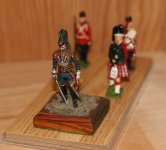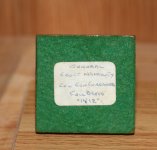Yes I agree, but it also could be Greenwood & Ball, similar era from UK, and I have just painted one, similar looking figure.
I can see that, too, John, you may be right.
Thanks, Brad, that is great info. The figure is 68 mm from the top of the wooden base to the top of his hat. What sort of time frame was there for the manufacture of these figures? Any info from the catalog would be really great.
Since reading your post I've done a bit of research and found both Charles and Andrew Stadden. Are the Stadden casting very collectible? As I said in my post, the same dealer had 5 -6 more, all in fairly good condition except for the added home-made bases.
I will eventually straighten the sword but I don't think that I will remove the wooden base. I think that here is too much risk of damaging the figure. I would also like to clean the figure but first I need to read the thread on cleaning.
Dan,
I have found a few figures, in similar condition that I have stripped and repainted. My own opinion is that they are worth collecting as they are representative of the better 54mm figures available in the 1970's and early 1980's and they don't make them in this manner anymore (copper sheet base, soldering, etc).
I would leave the figure as it is on the base unless you intend to strip and re-paint it. The last one I purchased (a Stadden) was on a similar base and the paint had faded and suffered some oxidation, hence the strip and repaint.
Scott
Thanks, Dan, and you're very welcome! I like when we get these puzzles to solve. I was looking for the answer to one of my own, when I stumbled across the forum some years ago.
To your question about Stadden figures--and Greenwood & Ball, for that matter--we're looking at a date range of the late 50's, for the very earliest, up to the mid-70's, if I'm not mistaken, for G&B, and up to 2007, in the case of the Stadden custom figures. They were dropped from the Tradition catalog due to low demand. I may have been the last person to have ordered one from Tradition.
Depending on the subject, Stadden foot figures start around $10 on the secondary market, but the price at any given time is speculative. I like to get them at $5 a pop, if I can. Mounted figures start around $15 to $20. If it's a portrait figure or a relatively rare subject (eg, British Horse Grenadiers of the Seven Years War), you might start at a higher asking price. However, these Staddens are relatively common on the secondary market. I don't collect Greenwood & Ball specifically, but my own observation is that they are a little rarer. I think it's safe to say that Tradition's output of Stadden castings is much higher than G&B's output.
As Scott said, both makers represent the highest standard available in the 60's and 70's. In their day, they were the First Legion, or St Petersburg, and some were finished to a very high standard by painters. With the advent of more kit makers producing more detailed white metal or resin kits, painters have more or less abandoned these (and so, Tradition drops them from the catalog). But that means more for me, and for the other collectors who look back fondly and with nostalgia on these ranges. I like the level of detail on the typical Stadden figure, though I paint mine in gloss colors (please feel free to have a look at my galleries), and they mix well with figures by Imrie-Risley, Rose (Gammage), Phoenix, Puchala, Peipp, as well as various smaller makers. I also like the animation. Since the figures were cast of a relatively softer alloy of tin and lead, they allowed a lot of variation in pose, and so no two are exactly alike.
As far as repainting goes, I used to use oven cleaner, but a couple of years ago, on a tip, I switched to an automotive de-greaser called SuperClean. It's available here in the states in discount department stores, like WalMart, and at automotive supply stores. It's not nearly as caustic to the skin as oven cleaner, whose active ingredient is lye, nor does it have the fumes, and you can use a batch more than once. I have read about a similar product, SuperGreen, which is supposed to be environmentally-friendly, and works the same way.
I would find a jar that fits the figure, fill it with the de-greaser, and let it sit. The paint will soften and can be scrubbed off with an old toothbrush, after about 15-20 minutes. If you can let the figure sit, eventually the paint will dissolve into solution completely, and I think that the glue bond to the wooden base may also be softened. You could then try to pop the figure off the wooden base, with a broad, flat knife blade.
You may also need to use other tools, like toothpicks (cocktail sticks, in the Commonwealth), straight pins, or old dental tools, to remove the paint from engraved detail. Once you've removed all the paint, rinse the figure, allow to dry, and then prime before painting. I use Walmart's house brand automotive primer for all my priming, toy soldier or scale model, metal, styrene or resin, but you may have your own preference. Mine is finely-grained enough, sticks well, and provides good "tooth" for the top layers of paint, and is much more reasonably priced than primers by the model supply makers.
I hope that all helps, and I wish you much enjoyment as you work on your figure!
Prosit!
Brad






